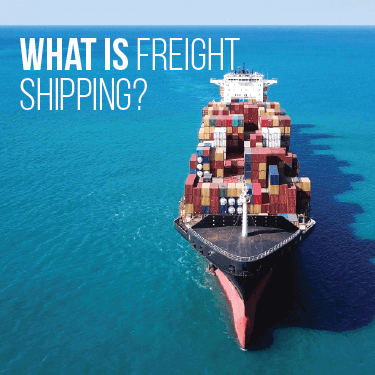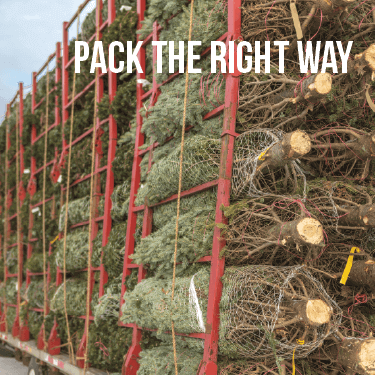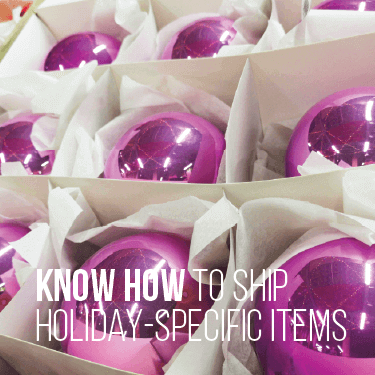The holidays are a stressful time for everyone, and the shipping and logistics industry is no exception. In fact, it’s the time of the year when the industry is at its busiest and most chaotic. As a result, holiday freight shipping can often seem like a logistical nightmare. Thankfully though, with the right approach and strategy, it doesn’t have to be.
The keys to successfully navigating the shipping industry during the holidays include proper communication, budgeting for higher seasonal rates, and accounting for delays. Those, among other helpful tips, can help you as you get ready to traverse the hectic holiday freight shipping season.
Our helpful guide below provides you with 10 useful tips to make the holiday freight shipping season successful and stress-free.

Simply put, freight shipping is the movement of goods or cargo across land, sea, or air. As opposed to parcel shipping, which is typically made up of smaller, individual packages, freight generally weighs over 150 pounds. Freight can also be classified as such if it has dimensions that are either 108 inches in length or 165 inches in length plus girth (2x width + height). Oftentimes, freight is shipped on pallets.
In the U.S., freight is most commonly shipped across the country by truck, using full truckload (FTL), less than truckload (LTL) or partial truckload (PTL) shipping. Freight can also be shipped by train, plane, ship, or intermodal, which is a combination of at least two of those methods.
The holiday shipping season is one of the busiest times of the year for freight service. Demand for goods is at its peak and the capacity to move those goods is at its most limited.
In the shipping and logistics industry, this is called the peak season. Peak shipping season traditionally runs from August through October, but can, and often does, carry over through the end of the year. Those months include the back-to-school rush, holiday shopping, and even surges in the agricultural industry.
It doesn’t help that the world’s simultaneous battle with, and recovery from the COVID-19 pandemic is creating even more difficulty for the industry this holiday season. While economies are improving and production is increasing across the board, many supply chains are still struggling.
With an increased demand for freight capacity and a decrease in drivers, shipping rates have risen across the board. That means that it’s more important than ever to look ahead early and create a plan for navigating the holiday season. Below, we’ve put together 10 tips that we think can give you a leg up and help you plan your holiday shipping strategy.
Good communication is one of the keys to success in life, and it’s no different in the world of shipping and logistics - especially during the holidays.
In order to successfully navigate the hectic holiday shipping schedule, good shipper-carrier relations are a must. Communicate with your carrier during every step of the process, making sure that both of you have all the necessary information to get the job done right.
It’s imperative to give your carrier information ahead of time, such as:
All of the above information ensures that you receive an accurate quote and an efficient and safe delivery.
If you don’t have the time or ability to stay in contact with your carriers, hire a freight broker. You’ll still need to communicate your needs and the necessary info to the broker, but they can take over the process from there. They’ll work to make sure that you and the carrier stay on the same page every step of the way.
The same goes for communicating with your customers. The last thing you want is to receive an order you weren’t prepared for, or for the customer to have unrealistic expectations. It’s important that both parties understand what is and isn’t possible before an order is even placed.

Just like any other market, the shipping and logistics market runs on supply and demand, and no time is that more evident than during peak season and the holidays.
More freight being moved means demand for more capacity. In turn, demand for more capacity means an increase in prices. That’s not a new concept, but with production bouncing back from pandemic lows and supply chains still in disarray, rates have shot up even higher than normal.
So what does this mean for you? The most simple and straightforward answer is that you need to budget accordingly to account for those increased rates. While they’ll go down eventually, it certainly won’t be until after peak season, and they’re not expected to dip back to normal levels until the end of 2022.
In the meantime, there are ways you can try to avoid the price surge. Plan your freight shipments so that you’re moving most of your volume before rates spike closer to the holidays. You’re always going to have to pay more for last-minute shipments, so get out ahead of the curve and move your freight as soon as possible. If you still have more to ship later on in the season, at least you won’t be getting hit with premiums on the bulk of your cargo.
Depending on how much freight you need to move and how quickly you need it delivered, you could also consider using an LTL (Less than Truckload) carrier. LTL is one of the most cost-efficient forms of shipping, allowing multiple shippers to share truck space, meaning you only pay for the space you use. It can take longer to deliver your shipment than full or partial truckload, but it minimizes costs and can help you stick to your budget.
The theme for most items on this list is to have a plan, but even the best-laid plans encounter stumbling blocks. One of the most common being delays, especially around the holidays.
Like we mentioned above, peak season means increased demand to move freight and limited capacity available to move it. Holidays are also a time when more people take off work, meaning there’s more work to be done and fewer service days to do it in.
Weather is often a huge factor in shipping delays as well. The winter months bring a higher likelihood of blizzards and snowstorms which are always a threat to shut down regional infrastructure, force reroutes and impact delivery dates.
The point is: The holidays create a perfect storm for potential delays, so don’t wait until the last minute. Budget in at least two additional days for each shipment. That way if something unexpected happens, you’ve got additional time to wait out the issue or come up with a solution.
One of the most important things to keep in mind when setting your holiday shipping schedule are the dates that your carriers won’t be working. Holidays mean the loss of valuable service and transit days which means it’s crucial to plan around them in order to get your shipments to their destination on time.
Every carrier sets its own holiday schedule, so while one might be working around the holidays, another might not. The most common days include Thanksgiving, Christmas Eve, Christmas Day, New Year’s Eve and New Years Day. The same goes for days directly before and after a holiday, as some carriers try to accommodate their employees by working limited hours those days, or by giving those days off entirely.
In a similar vein, holidays that land just before or after a weekend could cause similar issues. A three- or- four-day weekend that you didn’t plan for could mean the difference between getting your shipment out on time or having to wait until after the extended break.

For many businesses, the holidays are the busiest and most important time of the year, meaning that for better or worse, it’s when you’ll have the best chance to make a good impression on customers. Make sure that you actually give yourself that opportunity by properly packing your goods and cargo to make sure that your freight arrives safely and securely.
To start, make sure you pick the correct pallet for the job. It should be in good condition (no broken boards or gaps for your items to fall through) and strong enough to support your shipment without overhang.
Stack your boxes so that the heaviest boxes are on the bottom with lighter boxes on top. Whether you stagger or align the boxes is up to you, but make sure that your freight is properly balanced and the weight is distributed evenly across the pallet.
Once you’ve finished loading, it’s time to make sure your pallet is properly secured. Use a quality shrink wrap (i.e. 60-gauge) and make sure that the entire pallet is wrapped tightly several times over. Once or twice usually isn’t enough.
While shrinkwrap should be enough to secure most pallets, it’s never a bad idea to use straps to fasten it down as well. You should use two straps for each side, looped through the forks of the pallet, and ratcheted down to create a secure hold on your cargo.
Once everything is in place, you’re all set to begin loading your freight. Improper packing can lead to lost or damaged items. And as tempting as it is to rush the process, it’s in your best interest to take the extra time and ensure that all of your cargo is secure so it can make it to its destination in one piece.
Shipment tracking is pretty commonplace these days, but before you finalize your holiday carriers, make sure you know what visibility tools are available to you.
Some drivers use GPS trackers so you can actually see where your shipment is on a map at all times. Others give you a tracking number that you can use to view time-stamped updates on your shipment at each point along its route.
In order to plan better and communicate with both your team and your customers, it’s important to know the location and status of your cargo at all times. Check with your carrier before you begin the shipping process to see what visibility tools are available to you.
Just like any other insurance policy (auto, home, health, etc.), freight insurance is there to protect you in case of any loss or damage to your cargo. While it’s not required for shippers, it is highly recommended, especially at its fairly affordable price point.
The cost of freight insurance can vary based on a variety of factors, like your prior shipping record, freight classification, or the destination of your shipment. Every insurance provider is different, so make sure you do your research on what rates they offer or what factors they include when pricing their policy.
Generally speaking, though, the base cost of freight insurance is calculated as a small percentage of every $100 of a shipment’s total Commercial Invoice Value (CIV). That means that if the CIV of a shipment is $30,000, and the rate is 50¢ per $100, the base cost of the freight insurance would be $150.
It’s also important to note that carrier insurance is not freight insurance. While carriers have their own insurance policy, their liability coverage is unlikely to cover the costs of any loss or damage to your cargo, even if they’re responsible for the damages. Those policies are in place to protect the carrier, not the shipper, which is why freight insurance is sold as a separate policy.
While it’s never really a bad idea to have freight insurance, no time is it more important than during the holidays when you’re likely shipping your highest volume of the year and when a chaotic logistics schedule creates more opportunities for things to go wrong.

While toys, appliances and other retail items may be the first things you think of when it comes to holiday shopping, they’re far from the only things being shipped during the Fall and Winter months. In fact, the holidays bring with them a number of items that are only shipped during these months and require special care to move.
Pumpkins and Christmas trees are among the most popular items sold each holiday season, but due to their fragile nature and the fact that they can only be grown in certain areas of the country, they often require special attention and instruction to be shipped.
Specialized vehicles like refrigerated trucks and dry vans are often used to protect them from the elements and to regulate their temperature. And a balance needs to be struck when deciding when to harvest and ship these items so that customers can purchase them in time for display before they rot.
Thanksgiving turkeys are another favorite item around the holidays. Turkeys can be shipped fresh, frozen, or even live, all of which require their own specific logistic solutions. Not only do turkeys require specialized equipment to keep from perishing, but they must comply with a number Food and Drug Administration and U.S. Department of Agriculture regulations before they can be shipped.
If you’ve got an item that only ships around the holidays, chances are it’ll call for special treatment. Make sure that you’re properly prepared and know the logistics involved in shipping items that aren’t typivcally moved year-round.
Now that you’re ready to move your freight, it’s time to find the right shipping option for you. The majority of freight in the U.S. is moved by truck, but even truckload shipping offers several options to choose from.
While the delivery service you choose depends almost entirely on the amount of freight you’re shipping, one of the best options, especially for small and medium-sized businesses, is less than truckload (LTL) shipping.
LTL is typically used for freight that weighs between 150 and 15,000 pounds and only takes up a portion of a trailer. LTL gets a boost, particularly during the holiday and peak seasons, because it provides businesses a more cost-efficient mode of transport, and carriers a more streamlined shipping process.
With LTL, multiple shippers share the same trailer, meaning you only pay for the space you use, and not the full truck. While more cost-efficient, it’s important to note that the delivery of LTL freight can be slower, as carriers have to make multiple stops to unload each shipment.
If you’re shipping enough freight to justify an entire trailer, or if you’re shipment weighs more than 15,000 pounds, full truckload (FTL) shipping is probably the best option for you. Because trailer space is only occupied by one shipper at a time, FTL shipping is faster and safer for your cargo as it only requires one stop and one unload.
Partial truckload (PTL) is similar to LTL but usually involves larger shipments than the latter. Shippers generally use PTL when shipping freight that weighs more than 5,000 pounds or contains more than six pallets. That amount typically isn’t enough to fill a full trailer, but it’s more than the average LTL shipment.
One benefit that PTL has over LTL is that cargo shipped using PTL isn’t subject to freight class. That means that you could potentially save money, particularly if your freight is lighter than orders that normally take up a similar amount of space. While slower than FTL, PTL shipments stay in one trailer the entire trip and are subject to fewer stops than LTL.
Two other forms of shipping to be aware of are intermodal and multimodal, which each involve using a combination of at least two forms of transport. The most common method involves both truck and rail, but any combination of modes would qualify, including by sea or by air.
Intermodal shipping is most commonly used for shipments that require long distances. The majority of the transit time takes place on the train (or ship, or plane) before being loaded onto a truck to travel the rest of the way. Because rail uses less fuel than trucks, intermodal and multimodal shipping are typically cheaper than shipping by truck alone. Additionally, shipping this way can help reduce your carbon footprint.
One thing to note for intermodal shipping is that each mode of transport is handled by a separate carrier, meaning you need separate contracts for each. Multimodal, on the other hand, only uses one carrier, which means only one bill of lading.
If you’re not already using a freight broker, the holidays may be the right time to start looking into one.
Freight brokers act as the middleman between the shipper and the carrier, facilitating communication between both parties and ensuring that the entire shipping process runs smoothly from pickup to delivery.
A good carrier will do all of the heavy lifting for you and can be a great investment, especially around the holidays when you’re shipping higher volume and you don’t have the time to select carriers, plan routes, or track shipments.
Freight brokers work with a huge network of carriers, meaning they can find and properly vet the right carriers to meet your needs. Whether you’re looking to save money, increase capacity or move your cargo faster, a freight broker’s job is to find the right carrier for you.
Now that you’ve got all the tips necessary to successfully navigate the holidays, it’s time to find a partner that can help meet your freight shipping needs and get your cargo on the road. Get a truckload freight quote and discover how R+L Global Logistics can make a difference for you this holiday season.
R+L Global Logistics
315 NE 14th St., Ocala, FL 34470